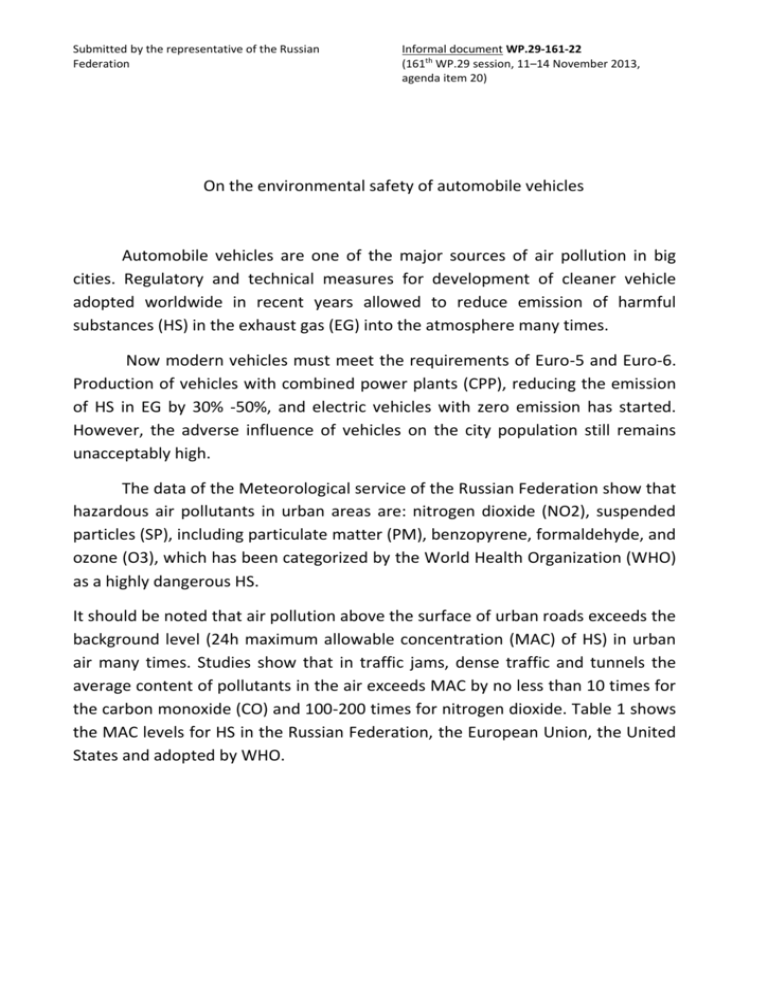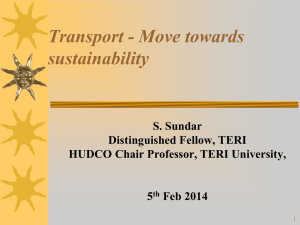On the environmental safety of automobile vehicles Automobile
advertisement

Submitted by the representative of the Russian Federation Informal document WP.29-161-22 (161th WP.29 session, 11–14 November 2013, agenda item 20) On the environmental safety of automobile vehicles Automobile vehicles are one of the major sources of air pollution in big cities. Regulatory and technical measures for development of cleaner vehicle adopted worldwide in recent years allowed to reduce emission of harmful substances (HS) in the exhaust gas (EG) into the atmosphere many times. Now modern vehicles must meet the requirements of Euro-5 and Euro-6. Production of vehicles with combined power plants (CPP), reducing the emission of HS in EG by 30% -50%, and electric vehicles with zero emission has started. However, the adverse influence of vehicles on the city population still remains unacceptably high. The data of the Meteorological service of the Russian Federation show that hazardous air pollutants in urban areas are: nitrogen dioxide (NO2), suspended particles (SP), including particulate matter (PM), benzopyrene, formaldehyde, and ozone (O3), which has been categorized by the World Health Organization (WHO) as a highly dangerous HS. It should be noted that air pollution above the surface of urban roads exceeds the background level (24h maximum allowable concentration (MAC) of HS) in urban air many times. Studies show that in traffic jams, dense traffic and tunnels the average content of pollutants in the air exceeds MAC by no less than 10 times for the carbon monoxide (CO) and 100-200 times for nitrogen dioxide. Table 1 shows the MAC levels for HS in the Russian Federation, the European Union, the United States and adopted by WHO. Table 1 The maximum allowable concentration (MAC) of major pollutants in the air Contaminant Averaging time СО NO2 О3 SО2 РМ10 Benzol USA, ЕU, мг/м3 З mg/ m 40 10 10 0,2 ( Should not be exceeded more than 18 times per year ) 0,125 ( Should not be exceeded more than 3 times per year ) 0,1 0,04 0,235 0,157 ? 0,350 ( Should not be exceeded more than 24 times per year ) 0,365 0,125 ( Should not be exceeded more than 3 times per year) 0,08 0,02 - 15 min. 30 min . 1 hour 8 hours 24 hours 30 min 1 hour Russia, mg/ mЗ 5 3 0,2 - WHO, mg/mЗ 100 60 30 10 0,2 24 hours 0,04 - Average per year 30 min . 1 hour 8 hours 24 hours 10 min 30 min 1 hour 0,16 0,03 0,5 - 0,04 0,12 0,5 - 24 hours 0,05 0,125 Average per year 30 min. 0,5 0,05 24 hours 0,15 - 0,15 Average per year 30 min 24 hours Average per year 0,3 0,1 - 0,05 6*10-6 0,08 - 0,05 ( Should not be exceeded more than 3 times per year) 0,02 0,005 - 2 As the table shows, the public health services of different countries and regions have not come to common standard MAC neither for short-term nor for daily average. One of the main problems is emission of particulate matter by vehicles. Studies performed in Moscow prove that up to 60% of PM in the air are products of tire wear, while the amount of particulate matter emitted with EG does not exceed 5%. Also, as noted in the document WP-29-160-39, it was measured that the release of tire tread wear product is 0.13 g/km for cars, 0.32 g/km for vehicles with full weight of up to 3.5 tonnes and 1.5 g/km for lorries and buses. This exceeds the Euro-6 standard for emissions of particulate matter in exhaust gas 26, 60 and 150 times, respectively. According to studies the content of PM in the air while driving on an asphalted road is 5 to 10 mg/m3 behind a passenger car, 15 to 20 mg/m3 behind two cars. The dust level at the engine and cab ventilation air intakes for a convoy of trucks driving with a gap of 35 m can reach 200 mg/m3 for the head vehicle, 1000 mg/m3 for the 6th, for 10 thvehicle and - 1100 mg/m3 for 10th, atwhile the specification of maximum allowable concentration norms are: 0.5 mg/m3 peak and a 0.15 mg/m3 daily average. Thus, we have an excess of PM at motorways of 20 to 40 times more than peak MAC and of 65-130 times more than averaged daily MAC. It was also established that the maximum dust concentration in the air at motorways occurs at the height of 0.5-1.0 m above the road surface and drops 35 times at the height of 2 meters or more. Therefore, it should be noted that air pollution inside driver cabins and passenger compartments can be the same as directly above the road surface. The summary data on the measurement of other HS content in the air above the roadway are: 35-70 mg/m3 for CO and NOx 2,0-10 mg/m3, and in the passenger compartments of cars - CO from 35 to 80 mg/m3; NOx from 3.0 to 12 mg/m3. According to the results of our studies (See Fig. 1), which are consistent with data of foreign researchers, the greatest air pollution occurs in the passenger compartments of cars, followed by the interiors of minibuses, buses, trolleybuses and trams in the order of lowering the HS levels. This happens due to the increased air pollution at the level of passenger compartment ventilation air intakes. 3 СО, mg/m3 60 50 40 30 20 MAC8 10 0 passenger car Taxi Trolleybus Tram Picture 1 – levels of CO content in passenger compartments of different autos in Moscow Therefore, solving the problem of reducing the harmful effects of vehicles on the health of drivers and passengers inside cars has greater relevance and importance at this stage than further tightening of regulations on the HS emission in the EG of new cars. Ensuring "environmental safety" of drivers and passengers should be considered a priority task for the working groups on vehicle safety (GRSG, GRSP, GRRF) and should be implemented through the development of additional hardware (devices) to clean up the air in the passenger compartments not only of new vehicles, but of all vehicles currently in use. However, all devices and systems that are currently installed to improve comfort in the interior (including ventilation, heating, climate control and air filtration) do not provide adequate protection for drivers and passengers. They create only an illusion of "environmental safety" inside vehicles. There are quite a number of publications dealing with the study and application of systems and methods of cleaning the air in the passenger compartments of vehicles from HS. Table 2 provides a summary on the applicable cabin air purifiers. 4 Table 2 Different cabin air purification devices № № Methods and systems of air purification Cabin air filter (paper) 1 2 Cabin air filter (paper + carbon) 3 Air purifier Ionizer 4 5 Removed harmful substances Fine dust Coarse (less NOX CO CH dust than 2mkm) Drawbacks Formalde hyde Soot + - - - - - ┴ + - - - ┴ ┴ ┴ - - - + + ┴ ┴ - - - + + ┴ ┴ - - - + + NI ┴ - - ┴ + + NI + + + + + + + + Ozonator Photocatalytic purifier 6 Coronary pulse discharge devices 7 New ecosystem of air purification Clears only the coarse dust, not produces cleaning NOx, CO, CH, formaldehyde Poor cleans the dust and the smell, does not make clear NOx, CO Does not clear the NOx, dust, produces O3 – harmful substances 1 hazard class Does not clear the NOx, dust, produces O3 – harmful substances 1 hazard class Does not clear the NOx, dust, large size and weight Unacceptably large amounts of energy, weight, dimensions, no dust removal Note: + - cleans the air – does not clean; ┴ - partly cleans, NI - no information. Modern cabin filters containing paper (item 1 of Table 2) and, in the best case, carbon filter media (paragraph 2) do not remove nitrogen oxides and carbon monoxide. It is their fundamental flaw. However, cabin air filters are not effective enough even for other substances. Due to the lack of standards for air purification quality the paper filtration media arrest only coarse-grained PM, which are much less toxic than finer suspended particles. 5 The amount of carbon used in modern cabin air filters is usually no more than 3040 grams, which is enough for partial removal of hydrocarbons and smell from the air in the passenger compartments for 1.5 - 3 thousand kilometres in urban areas. As a result, even hybrid and electric vehicles cannot be considered environmentally safe types of transport for their drivers and passengers. Air-ionizers (item 3 of Table 2) and ozone generators (item 4) clean the air only from CO and some groups of hydrocarbons. However, they do not remove NO2, NO and are ineffective for formaldehyde. But the main drawback is that they generate and supply to the cabin ozone – O3, the presence of which in the air above the hygienic standard is extremely dangerous. In the USA, where the use of ozone generators started much earlier, independent experts conducted numerous experiments to determine the real potential of ozone as an air purifier. These studies yielded the following conclusions: - Ozone does not improve the quality of air at concentrations conforming to health standards; - The content of Ozone often exceeds the permissible limits even when all recommendations of their user manuals are strictly met. Photocatalytic purifiers (p.5 Table 2) and coronary pulse discharge devices (item 6 of Table 2) never achieved mass use in vehicle cabins due to lack of efficiency and other causes. Summarizing the above it can be concluded that none of the types of air purification devices presented in rows 1 to 6 in Table 2 provide effective cleaning of the air from all types of HS. The main reason for this situation lies in the shortcomings of the current concept of "environmentally clean" transport, which lacks integral environmental requirements for vehicle design concerning ventilation, heating, air conditioning and cabin filters. The most promising means of air purification may be new integrated air purification system, which require technologies for efficient removal of nitrogen oxides, carbon monoxide, particulate matter, ozone and carcinogenic substances to be developed. 6 As for cabin air filters, it is certainly necessary to develop technical requirements and improve their design to ensure quality of fine-grained PM removal. Their lifetime should be increased to clean the air from HS for 15 000 km and they must be replaced during regular maintenance of motor vehicles. 7





